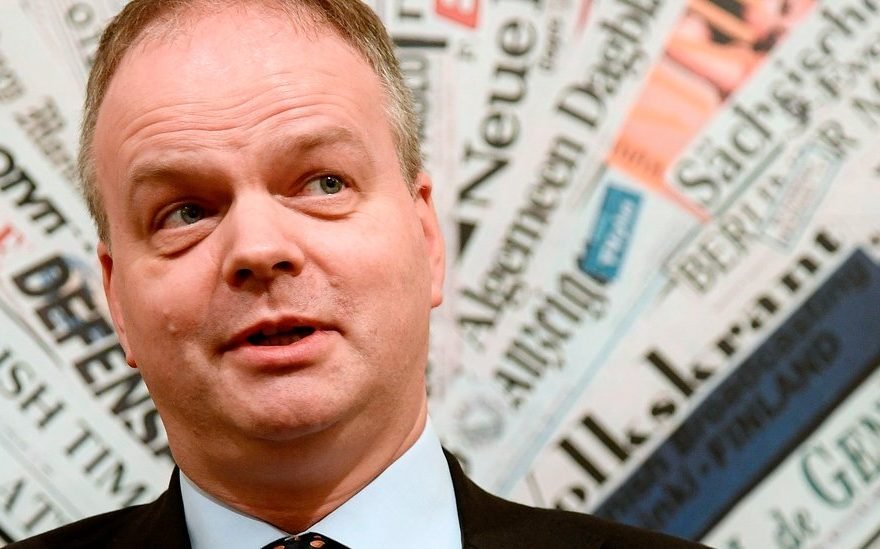ROME — Less than a month before Eike Schmidt was meant to leave his post as the director of the Uffizi Gallery in Florence to lead the Kunsthistorisches Museum in Vienna, the German art historian announced on Wednesday that he had changed his mind.
“Florence is too close to my heart,” he told reporters at an impromptu news conference at the Uffizi, hastily called after Austrian news media leaked the decision and cited an angry reaction from Alexander Schallenberg, the Austrian culture minister.
“This last-minute cancellation is highly unprofessional and actually unprecedented,” Mr. Schallenberg, who is also the foreign minister, told Die Presse, the Austrian newspaper that first reported the story.
Mr. Schmidt, who was named director of the Uffizi in 2015 on a four-year contract, said he wanted to stay at the Florence museum to continue the ambitious program of change he had begun there. But his reappointment is not a done deal: Mr. Schmidt will need the endorsement of the Italian culture minister, Dario Franceschini.
In a statement, Mr. Franceschini said on Wednesday that before he could examine Mr. Schmidt’s request to stay on for another four years, which, he noted, “was permitted by law,” he would need assurances “that this decision would not have created any problems with Austria and the Austrian government.”
That may be a stumbling block for Mr. Schmidt, who has been denounced in the Austrian news media and attacked sharply by politicians. Thomas Drozda, a former culture minister of Austria, told the daily newspaper Der Standard that Mr. Schmidt had left the Kunsthistorisches Museum hanging, and that his decision was “disgraceful” and showed a lack of character.
Nina Auinger-Sutterlüty, a spokeswoman for the Kunsthistorisches Museum, said she could not comment directly on the museum’s contract with Mr. Schmidt or on whether there would be financial repercussions for breaking it.
On Thursday, Claudia Türtscher, a spokeswoman for the Austrian Culture Ministry, said officials were “focused on making sure the Kunsthistorisches Museum is guided by a steady hand.”
“Our experts will check everything else to do with the contract,” she added.

In a telephone interview, Mr. Schmidt said that the news reports had upended an “exit strategy” he had been discussing privately with the Kunsthistorisches Museum’s current director, Sabine Haag, intended to allow them both to stay in their current roles.
“The idea was to work in perfect harmony, because she was immediately very enthusiastic about the idea when I tested the waters with her last week,” Mr. Schmidt said.
But Mr. Schmidt acknowledged that neither he nor Ms. Haag had a say in whether she could stay in her current post: That is up to the Austrian culture minister.
“I have no idea who leaked it out before actually we met the minister,” Mr. Schmidt said. “That’s how he got upset, learning from the press.”
Austrian news reports have focused on rumors that Mr. Schmidt actually wanted to say in Italy all along. But he said he had been “very much determined to go to Vienna, otherwise I wouldn’t have actually gone to Vienna regularly,” including “on my vacation time.”
Mr. Schmidt said that recent changes in the Italian government that returned Mr. Franceschini to the Culture Ministry had “played a major role in my thought process.”
Mr. Schmidt was one of 20 directors hired four years ago to lead Italy’s top museums, part of an overhaul by Mr. Franceschini.
Elections in 2018 ousted Mr. Franceschini’s party, and the new culture minister, Alberto Bonisoli, introduced a decree last June that shifted control over state museums and other sites back to the ministry in Rome, reducing the autonomy of individual institutions. That decree has now been postponed.
But the center-right government that Mr. Bonisoli was part of fell in August, when one of the coalition partners withdrew its support, and Mr. Franceschini was named culture minister again last month when a center-left government took office.
Mr. Franceschini’s “decision to carry on with the museum reforms, and keep the museum directors’ roles as they were defined” influenced Mr. Schmidt’s desire to stay, he said.
Mr. Schmidt added that he had not made the choice lightly and that it had weighed on his mind. But the Kunsthistorisches Museum would be in safe hands if Ms. Haag was allowed to continue, he said.
Mr. Schmidt said that he hoped talks with Mr. Schallenberg would resolve the current ill will, adding that he wanted to schedule a meeting in the coming days.
“I am very confident that all this will be calming down very soon,” Mr. Schmidt said.
Ms. Auinger-Sutterlüty, the Kunsthistorisches Museum spokeswoman, said the institution’s day-to-day running would not be affected by Mr. Schmidt’s decision.
“An established and important museum such as the Kunsthistorisches Museum is set up to function perfectly, even in situations like this,” she said.
“We have programs set up for 2020 and 2021,” she said. “We don’t want for objects, ideas or exhibitions.”
Elisabetta Povoledo reported from Rome and Christopher F. Schuetze from Berlin.



Elisabetta Povoledo has been writing about Italy for nearly three decades, and has been working for The Times and its affiliates since 1992. @EPovoledo • Facebook
Christopher F. Schuetze joined the Berlin bureau of The New York Times in 2018 to help cover German politics, society and breaking news as a reporter and researcher. @CFSchuetze
Source: Read Full Article
